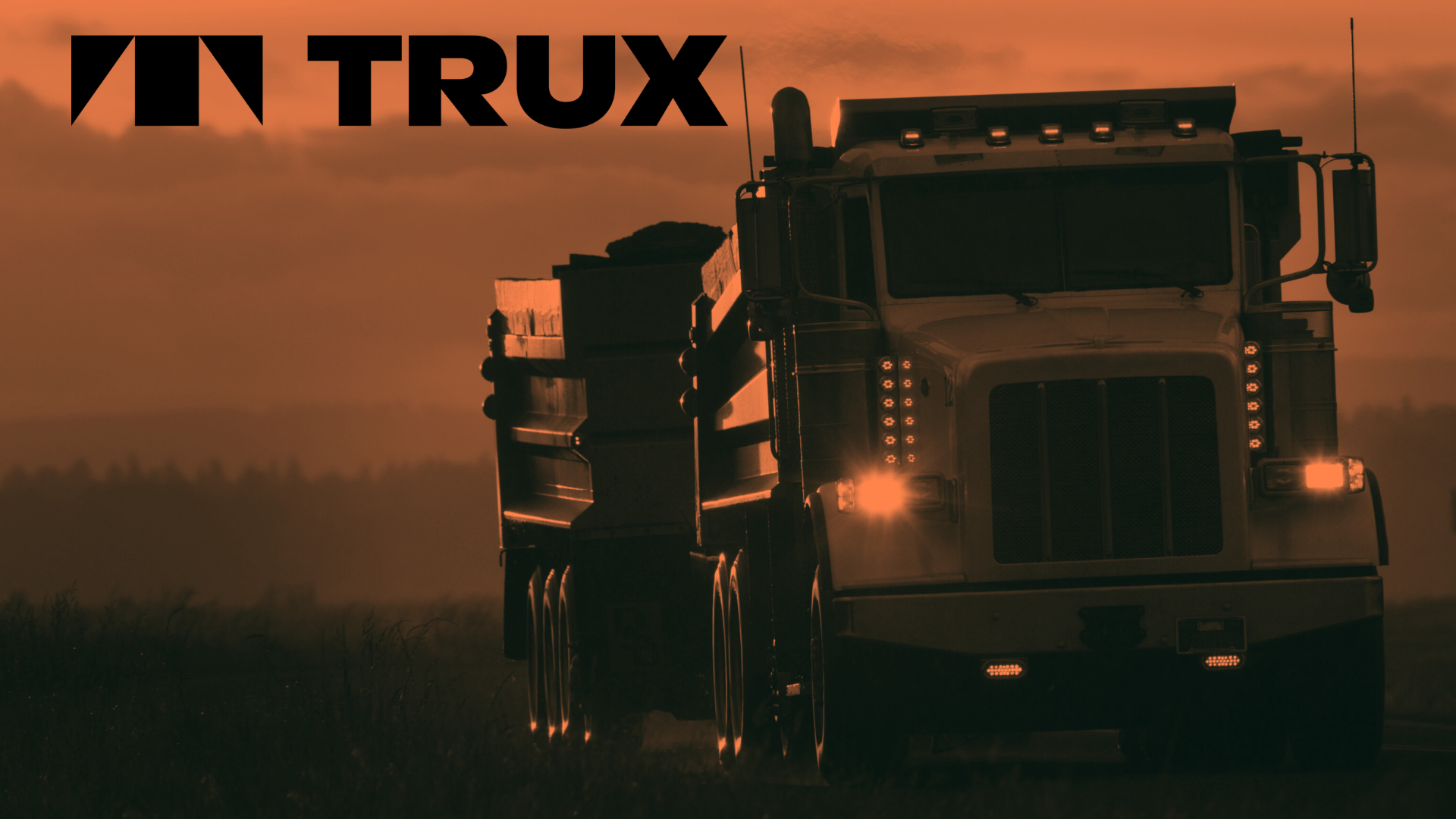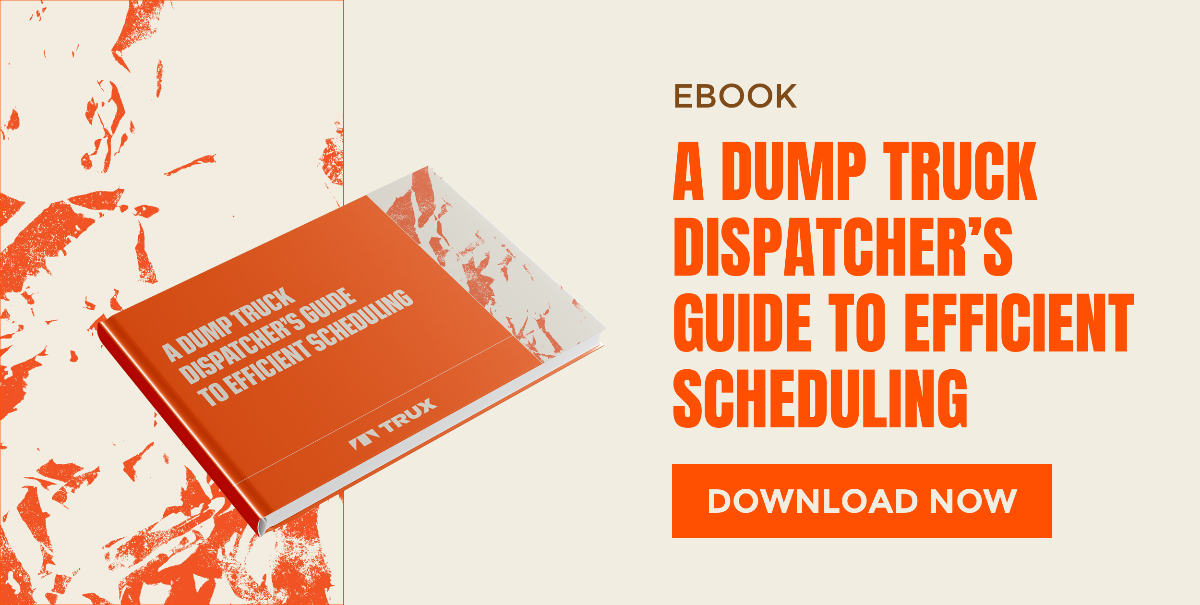7 min read
How to Increase Capacity Without Adding More Trucks
By: TRUX Team on Oct 11, 2024 8:44:04 AM

Hauling efficiency is key to maximizing profits. Every minute a truck is moving material instead of sitting idle increases your productivity. But when faced with rising demand, adding more trucks isn't always the best solution—it drives up costs, requires more drivers, and complicates management. The better solution? Make the most of the trucks you already have.
In this post, we’ll walk through some simple, practical ways you can cut hauling downtime without adding more trucks. We’ll show you how to improve efficiency, keep your jobs running smoother, and make sure your trucks are hauling instead of sitting. Plus, we’ll cover how Trux can help you make it all happen.
Click a topic below to jump to the relevant section:
Understanding Hauling Downtime
Tip 1: Optimize Dispatching and Scheduling
Tip 2: Streamline Material Flow
Tip 3: Maximize Driver Productivity
Tip 4: Leverage Data for Long-Term Optimization
The Role of Trux in Increasing Capacity
Understanding Hauling Downtime
Downtime isn’t just about trucks sitting idle. It’s about trucks not doing as much as they should be. This can happen in several ways—waiting too long to get loaded, dealing with slow unloading processes, or facing holdups at the job site. These delays add up, making it harder to stay efficient.
So, what causes these delays? At the loading site, it could be poor coordination between dispatchers and loaders, or a lack of real-time communication about truck arrival times. On the unloading side, it might be that job sites aren’t prepared to receive the material when it arrives, or there’s confusion about where and when the load needs to be dropped. Delays at the job site often come from mismanaged schedules, unclear instructions, or material not being ready to move when your trucks roll in.
These issues eat into your productivity. When trucks are tied up in unnecessary waits, they’re not accomplishing as much as they should. And that’s not just frustrating—it’s costly. Time is money, and the longer these delays last, the more your bottom line takes a hit. Reducing downtime by fixing these common problems will not only keep your trucks moving but also protect your profits.
Tip 1: Optimize Dispatching and Scheduling
The first step to increasing capacity is getting smarter about dispatching and scheduling. If your trucks are waiting around for the next job or arriving at the wrong time, you’re wasting valuable hours. This is where using real-time data from Trux can make a huge difference.
With Trux, you get live GPS tracking and updates, so you always know where your trucks are and can dispatch them more efficiently. Instead of guessing or relying on outdated schedules, you can make decisions based on real-time information. This means your trucks spend less time waiting and more time working.
Communication is another key factor. When dispatchers, drivers, and job sites aren’t on the same page, it leads to delays. Trux’s platform allows for seamless communication between all parties, so everyone knows what’s happening and when. This cuts down on confusion and keeps things running smoothly.
For example, using Trux's delivery tracker, job sites can see exactly when a truck is arriving and prepare for the load ahead of time. This means workers can have equipment and personnel in place to unload the material quickly, avoiding unnecessary delays. When everyone is ready before the truck pulls in, your drivers spend less time waiting around, and the material gets where it needs to go faster. Optimizing dispatching and scheduling, with tools like Trux’s delivery tracker, helps you keep things moving and get more done with the trucks you already have.
Tip 2: Streamline Material Flow
Keeping materials moving smoothly is key to increasing capacity and keeping your trucks productive. When you have clear visibility into the flow of loads, you can avoid the bottlenecks that slow everything down. That’s where Trux comes in, giving you real-time insight into your hauling operations.
With Trux, you always know the status of your trucks—whether they’re loaded and on their way to a job site or returning empty and ready for the next load. This visibility helps you make quick decisions to keep things moving. If more material is needed on-site, you can easily schedule additional trucks based on real-time data. No more guessing or waiting until it's too late—Trux gives you the flexibility to react instantly to job demands.
Another way Trux helps streamline material flow is by allowing you to dispatch trucks at staggered times to the same project. This helps you avoid overcrowding at loading or unloading sites, preventing unnecessary delays. By spacing out arrivals, your trucks can load and unload efficiently without creating bottlenecks.
The combination of real-time visibility and smarter scheduling helps keep your materials moving at the right pace, so your trucks spend more time hauling and less time waiting.
Tip 3: Maximize Driver Productivity
When it comes to increasing capacity, making sure your drivers are as productive as possible is key. If they’re spending too much time waiting between loads or sitting idle, you’re not getting the most out of your crew. By using tools like Trux, you can keep your drivers on the move and ensure every hour on the clock is being used effectively.
One of the big advantages of Trux is the ability to minimize idle time. With GPS tracking and real-time updates, dispatchers can see where every truck is at any given moment. This means you can assign jobs to the closest available driver, cutting down on unnecessary trips and reducing the time spent waiting between assignments.
Another benefit is that Trux helps you prioritize jobs more efficiently. If a driver finishes a job and is closer to another site that needs material, you can quickly assign them that job, instead of waiting for a scheduled load. This keeps your trucks working steadily throughout the day, without long gaps between loads.
By keeping your drivers moving and reducing idle time, you’re making the most of your team’s capacity. The result is fewer delays, more completed jobs, and a noticeable impact on your bottom line. Trux’s real-time data and dynamic scheduling make it easier to keep your drivers productive and focused on what matters—hauling more material.
Tip 4: Leverage Data for Long-Term Optimization
Increasing capacity isn’t just about making quick fixes—it’s about understanding the bigger picture and using data to make smarter decisions for the long haul. Trux provides detailed insights into your hauling operations, allowing you to spot trends, identify recurring issues, and make long-term improvements.
With Trux’s data, you can track how often downtime is happening, where it’s occurring, and what’s causing it. Maybe it’s a particular job site that regularly experiences delays, or a pattern of underutilized trucks. Once you have this information, you can make targeted adjustments to improve efficiency.
Trux’s data also helps you understand truck utilization better. You can review how often each truck is actively hauling versus waiting, helping you adjust your schedules and assignments to get the most out of your fleet.
By consistently using data to fine-tune your operations, you can reduce downtime not just today but for the long term. It’s about creating a more efficient, productive operation that maximizes the value of every truck and every load. Trux gives you the tools to turn data into actionable insights for continuous improvement.
The Role of Trux in Increasing Capacity
When it comes to Increasing capacity, Trux plays a vital role in keeping operations smooth. It’s more than a scheduling tool—it’s a full platform providing visibility and control over your hauling operations.
With Trux, you always know where your trucks are and what they’re doing in real-time. This allows for quick adjustments, whether it’s sending more trucks to a job site or staggering deliveries to avoid bottlenecks. With this level of visibility, delays are minimized, and trucks are used more efficiently.
A great example of this is Vulcan Materials, the largest producer of construction aggregates in the U.S. By using Trux, Vulcan was able to boost their loads per truck by 2.5, reducing downtime and improving overall efficiency. The platform’s real-time delivery tracking helped job sites prepare for incoming loads, streamlining operations and cutting down wait times.
Trux also simplified communication by connecting dispatchers, drivers, and job sites through one platform. With everyone on the same page, confusion and delays caused by miscommunication were drastically reduced.
Vulcan’s success shows how Trux can transform hauling operations, increasing productivity and profitability by reducing downtime. It’s not just a tool—it’s a solution that gives you the insights and control needed to keep jobs running on time and trucks busy.
Conclusion
Increasing capacity downtime doesn’t have to mean adding more trucks to the fleet. By optimizing dispatching, streamlining material flow, and improving communication, you can make the most of your existing resources. With Trux, you gain the real-time visibility and control needed to keep your trucks moving and your jobs on track.
As Vulcan Materials demonstrates, using Trux can lead to significant improvements in efficiency, reducing downtime, and boosting productivity. If you’re ready to take control of your hauling operations, it’s time to explore how Trux can help you do more with what you already have.
Related Posts
Reducing Downtime: Best Practices for Hauling Operations
When your operation relies on steady material movement, downtime isn't just an inconvenience—it’s a...
Effective Project Management: Key to Staying On Schedule and Within Budget
When it comes to dump truck operations, efficiency isn’t just a goal—it’s the difference between...
How Smarter Hauler Management Helps You Do More with the Trucks You Already Have
Think you need more trucks to move more material? Not necessarily.
In today’s environment, trucking...

